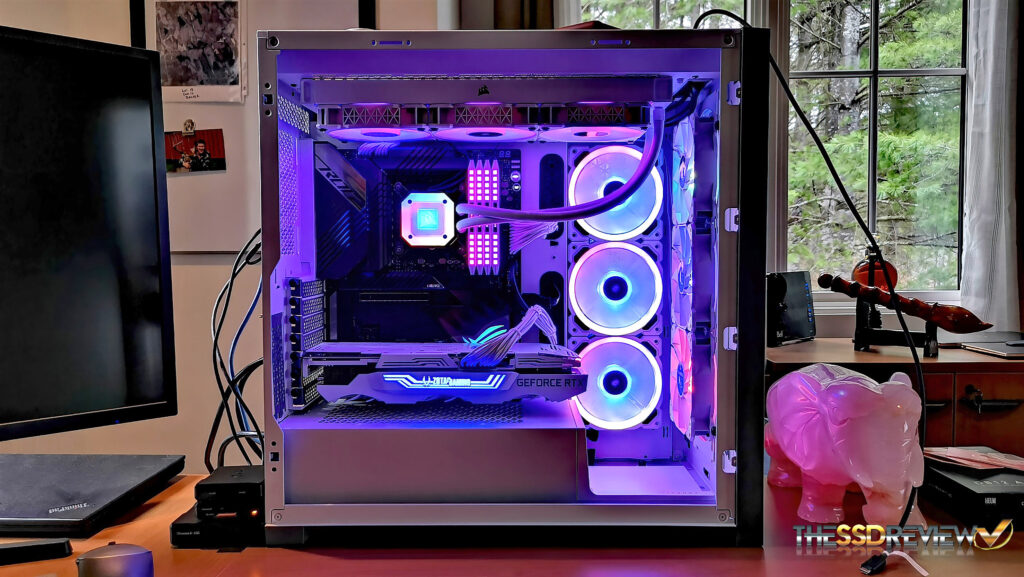TSSDR TEST BENCH AND PROTOCOL
SSD testing at TSSDR differs slightly, depending on whether we are looking at consumer or enterprise storage media. In today’s testing, we will be evaluating the Seagate FireCuda 530 in our newest Intel Gen 4 Test Bench. This PC has been optimized to provide the absolute highest performance available using our SSD Optimization Guide.
INTEL Z590 PCIe 4.0 TEST BENCH
For this Test Bench, the CPU C-States, Enhanced Intel SpeedStep Technology (EIST) and Intel Speedshift (P-States) have not been disabled. As you will see below, the system is also bumped to 5.3GHz with memory at full speed in its XMP 2 profile.
The components of this Test Bench are detailed below. All hardware is linked for purchase and product sales may be reached by a simple click on the individual item. As well, the title is linked back to the individual build article where performance testing can be validated. Clicking on the Title below will bring you to our complete report on this new Gen 4 PC system.
INTEL Z590 PCIE 4.0 COMPONENTS (Click for System Report)
| PC CHASSIS: | Corsair 5000X RGB White Tempered Glass Chassis |
| MOTHERBOARD: | ASUS ROG Maximus XIII Z590 Hero Gen 4 |
| CPU: | Intel 11th Gen Core i9-11900K |
| CPU COOLER: | Corsair Hydro Series H150i Capellix White |
| POWER SUPPLY: | Corsair RM850x 80Plus White |
| GRAPHICS: | ZOTAC GeForce RTX 3080 Trinity White |
| MEMORY: | Corsair Dominator Platinum RGB DDR4-3200 32GB |
| STORAGE: | Sabrent Rocket 4 Plus Gen 4 4TB NVMe SSD |
| KEYBOARD: | Corsair K70 RGB Mk. 2 SE White Gaming |
| MOUSE: | Corsair M65 RGB Elite FPS Gaming |
| MONITOR: | Samsung 34″ 1440p WQHD Ultrawide Gaming |
BENCHMARK SOFTWARE
The software in use for today’s analysis is typical of many of our reviews and consists of Crystal Disk Info, ATTO Disk Benchmark, Crystal Disk Mark, AS SSD, Anvil’s Storage Utilities, AJA, TxBench, PCMark 10, as well as true data testing. Our selection of software allows each to build on the last and to provide validation to results already obtained. At first glance, one might think that AMD has the definite advantage. Watch closely though as we walk you through PCMark as well as True Data Testing, in addition to our typical regimen of benchmark software.
CRYSTAL DISK INFO VER. 8.11.2 X64
Crystal Disk Info is a great tool for displaying the characteristics and health of storage devices. It displays everything from temperatures, the number of hours the device has been powered, and even to the extent of informing you of the firmware of the device.
Crystal DiskInfo validates that our SSD is running in PCIe 4.0 x4, using the NVMe 1.4 protocol and confirms that it is TRIM capable. On the top right, we can see that we have put through more than 2TB in both Total Host read and writes.
 The SSD Review The Worlds Dedicated SSD Education and Review Resource |
The SSD Review The Worlds Dedicated SSD Education and Review Resource | 


You didn’t mention it, but I guess this has Micron’s newest B47R Fortis 3D TLC memory that is in the Phison E18 B47R Fortis NVMe Gen 4 SSD Evaluation Sample Preview you reviewed a little while ago? If so, then I guess this would be the first commercially-released SSD with this new memory.
However, the Phison E18 B47R Fortis NVMe Gen 4 SSD Evaluation Sample Preview lists a little better in the low 4K read and write speeds. Could this be due to different firmware, or just a difference in test samples?
Great stuff, Dave.
Was about to ask the same question.
Would be cool if you could make a toplist of currently fastest ssds..